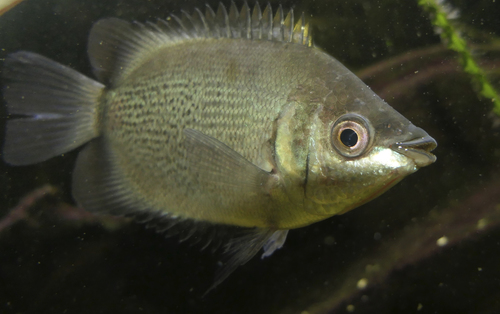
Kissing Gourami
The Atlantic Bluefin Tuna (Thunnus thynnus) is a highly migratory, large pelagic fish renowned for its size, speed, and commercial value. It's a top predator in the marine ecosystem, playing a crucial role in maintaining the balance of ocean life. This species is notable for its unique physiology, including its warm-bloodedness, which is rare among fish.
5 25 years
Lifespan
30 cm
Length
Least Concern
Conservation Status
Omnivorous, Filter Feeding
Diet
Local Migration
Migration
Appearance Overview
The Atlantic Bluefin Tuna exhibits a robust, streamlined body, perfectly adapted for speed and endurance in the water.
Color
Dark metallic blue above, silvery white below
Body Shape
Torpedo-shaped, designed for efficient swimming
Fins
Two dorsal fins, the first depressible; small, yellow finlets running from dorsal and anal fins to the tail
Length
Commonly up to 6.6 feet (2 meters), maximum recorded at 10 feet (3 meters)
Weight
Typically around 550 lbs (250 kg), but can reach up to 1,500 lbs (680 kg)
Diet
Carnivorous, feeding on a variety of fish, squid, crustaceans, and occasionally, zooplankton and eel.
Feeding Behavior
Highly active predator, uses speed and agility to chase down prey. They are also known to dive to considerable depths in search of food.
Social Behavior
Exhibits schooling behavior, often forming large, age-specific groups. They are migratory, traveling long distances across oceans.
Commercial Relevance
Extremely high value, especially in the sushi and sashimi markets, where its fatty flesh is considered a delicacy.
Conservation measures
Subject to international fishing quotas and management plans, including minimum size limits and seasonal closures. Efforts also include tagging programs to monitor populations and migration patterns.
Status
Endangered (IUCN)
Threats
Historically heavily overfished, particularly due to demand in high-end sushi markets. Other threats include bycatch in fishing gear and habitat degradation.
Habitat Distribution
Depth Range
Typically found from the surface to depths of 1,600 feet (500 meters), but can dive much deeper.
Geographic Range
Western and Eastern Atlantic Ocean, Mediterranean Sea, and formerly the Black Sea.
Preferred Environment
Prefers temperate and subtropical waters; highly migratory, often crossing entire oceans.
Reproduction and Life Cycle
Breeding Habits
Spawns in two main areas: the Mediterranean Sea and the Gulf of Mexico. Spawning typically occurs in warmer waters during specific times of the year.
Development Stages
Eggs hatch into larvae, which are planktonic. Juveniles grow rapidly, feeding voraciously. They transition through several life stages before reaching full maturity.
Fecundity
Highly fecund; a single female can produce up to 30 million eggs per spawning season.
Maturity Age
Reaches sexual maturity relatively late, typically between 4-8 years of age, depending on the population.
Faqs about Kissing Gourami
How long do Atlantic Bluefin Tuna live?
Atlantic Bluefin Tuna can live up to 40 years, although this is rare due to fishing pressure.
How fast can Atlantic Bluefin Tuna swim?
They are among the fastest fish in the ocean, capable of bursts of speed up to 43 mph (70 km/h).
Are Atlantic Bluefin Tuna warm-blooded?
Yes, they are warm-blooded, which allows them to maintain a higher body temperature than the surrounding water, aiding in muscle efficiency during high-speed pursuits.
Where are Atlantic Bluefin Tuna found?
Atlantic Bluefin Tuna are found in the Atlantic Ocean, ranging from the cold waters of the North Atlantic to the warmer tropical waters of the Gulf of Mexico and the Mediterranean Sea.
What is the biggest threat to Atlantic Bluefin Tuna?
The primary threat is overfishing, driven by the high commercial value of their meat.
How deep can Atlantic bluefin tuna dive?
Atlantic bluefin tuna can dive to depths greater than 3,000 feet.
Copyright @ Nature Style Limited. All Rights Reserved.
 English
English